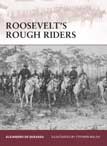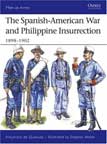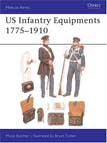

Osprey's examination of the brief but colorful history of the 1st US Volunteer Cavalry, detailing the rich experiences of the men who fought in its ranks. Founded in May 1898, the unit's actions in Cuba during the Spanish-American War (1898) have passed into military and national legend. The men who volunteered for the force came from a broad spectrum of American society, including seasoned ranch hands and cowboys, college athletes, and policemen. The unit was posted to Cuba in June 1898, where the 1st US Volunteer Cavalry fought in the battles of Las Guasimas, Kettle Hill and San Juan Hill. At this time, its commander, Colonel Leonard Wood, took charge of the US 2nd Cavalry Brigade, leaving Theodore Roosevelt to assume command of the 1st US Volunteer Cavalry. The unit subsequently became known as 'Roosevelt's Rough Riders', after Buffalo Bill's popular cowboy show that featured 'Rough Riders of the World'. Many of the volunteers were struck down by disease and sickness during the campaign, and the unit was eventually withdrawn, returning to a hero's welcome in the US. The last veteran of the unit died in 1975, but a rich body of source material has survived, and much of this is covered in this fascinating work.
In 1898 US public opinion turned against the Spanish for their repression of Cuba. Relations between the two governments soured and ultimately resulted in the mysterious blowing up of the USS Maine in Havana harbor, which triggered a short but demanding war.
A US expeditionary force was sent to Cuba, where the troops encountered both difficult climate and terrain, and a fierce Spanish garrison which, despite being greatly outnumbered, fought hard before surrendering.
Many famous US personalities were involved, including future President Theodore Roosevelt, future general John Pershing, and journalists William Randolph Hearst and Stephen Crane.
The war against the Spanish may have been brief but as Henry Cabot Lodge declared: "Its results were startling, and of world-wide meaning." Victory made the US a nation with global interests.
As an extension of the war, US troops also captured the island of Puerto Rico. The US Navy bombarded Manila in the Philippines, and landed its troops. The Spanish garrison quickly surrendered, but a local anti-Spanish insurgent force under Emilio Aguinaldo resisted US occupation. The conflict continued until 1902, more than 100,000 US troops were eventually committed, and the campaign saw difficult jungle fighting, with indigenous Moro tribesmen fiercely resisting US forces.
Providing a detailed examination of the experiences and equipment of the opposing sides, and featuring rare and previously unpublished photographs, this book highlights this crucial yet oft-forgotten war that changed the future of American foreign policy during "the age of American imperialism."
The development of US Army infantry equipment has been a story of trial and error, of adopting new designs to meet new problems. It was not until 1910 that a whole system of equipment, including everything from the waist belts to the canteens to the cartridge-carriers to the haversack, was officially adopted. Prior to that, each piece of equipment was designed to meet a specific need, without any consideration of anything else the soldier had to carry. Packed with photographs and illustrations, this book explores the history of US Infantry equipments from 1775 to 1910, covering everything from blankets to bayonets.
St. Fabian ends his reign as Catholic Pope (236-50)
Book of mother, published
Giovanni di Sabina elected Pope Sylvester III
1st English Parliament called into session by Earl of Leicester
Duke Wladyslaw Lokietek becomes King of Poland
Scottish King Edward Baliol resigns
Casa Contratacion (Board of Trade) found (Spain) to deal with American affairs
Christian II succeeds Johan I as Danish / Norwegian King
Cornerstone of Amsterdam townhall laid
Treaty of Andrussovo-ends 13 year war between Poland and Russia
1st American military court martial trial begins, Cambridge, Massachusetts
1st edition of Pieter It Hoens "Post of Neder-Rhijn" published
Hostilities cease in Revolutionary War
Samuel Ellis advertises to sell Oyster Island (Ellis Is), no takers
Pioneer African Baptist church organizes in Savannah, Georgia
John Marshall appointed US Chief Justice
Napoleon convenes great Sanhedrin, Paris
1st US geology book published by William Maclure
Dutch King Willem II crowned
China cedes Hong Kong to British
Investigator, 1st ship to effect northwest passage, leaves England
Dutch troops conquer Watampone in Celebes
Florida constitutional convention meets in Tallahassee
Elizabeth Cady Stanton becomes 1st woman to testify before Congress
"City of Boston" vanishes at sea with all 177 aboard
Hiram R Revels elected to fill unexpired term of Jefferson Davis
California Stock Exchange Board organized
British troops under Lord Chelmsford set camp at Isandlwana
Billy Barnes takes a hat-trick, England vs. Aust MCG
US Senate approves naval base lease of Pearl Harbor
1st basketball game played (Mass)
Ottawa Senators sweep Edmonton in 2 for Stanley Cup (2nd of 1910)
Dutch 2nd Chamber passes school laws
British submarine K5 leaves with man and mouse
Dagestan ASSR forms in RSFSR
Mountain Autonomous Republic established in RSFSR
Turkey declared in remnants of Ottoman Empire
USSR and Japan sign treaty of Peking, Seychelles back to USSR
2nd German government of Luther begins
1st feature talking motion picture taken outdoors, "In Old Arizona"
1st radio broadcast of "Lone Ranger" (WXYZ-Detroit)
Japan sends Henry Pu Yi as regent to Emperor of Manchuria
Edward VIII succeeds British King George V
1st Inauguration day on Jan 20th, (held every 4th years there-after)
Hitler proclaims to German parliament to exterminate all European Jews
Japanese invade Burma
Operation-Weiss: Assault of German, Italian, Bulgarian and Croatian
RAF drops 2300 ton bombs on Berlin
FDR sworn-in for an unprecedented 4th term as President
F Gouin follows De Gaulle as temporary leader of French government
Brigadier General Edwin K Wright, USA, becomes Deputy Director of CIA
J Edgar Hoover gives Shirley Temple a tear gas fountain pen
President Truman announces his point 4 program
"Dance Me a Song" opens at Royale Theater NYC for 35 performances
Suriname becomes independent part in Realm of the Netherlands
British army occupies Ismailiya, Suez Canal Zone
Louise Suggs wins LPGA Tampa Golf Open
1st live coast-to-coast inauguration address (Eisenhower)
1st US telecast transmitted to Canada-from Buffalo, New York
1st atomic sub, USS Nautilus, launched at Groton Conn
Buddy Holly records "Blue Days Black Night" in Nashville
Betsy Rawls wins LPGA Tampa Golf Open
Betsy Rawls wins LPGA Tampa Golf Open
KUED TV channel 7 in Salt Lake City, UT (PBS) begins broadcasting
Patrice Lumumba sentenced to 6 months in Belgian Congo
Arthur M Ramsay becomes Archbishop of Canterbury
Yugoslav ex-Vice President Milovan Djilas flees
"Kean" closes at Broadway Theater NYC after 92 performances
Beatles appear on Shindig (ABC-TV)
Byrds record "Mr Tambourine Man"
Generalissimo Francisco Franco meets with Jewish representatives to discuss legitimizing Jewish communities in Spain
JPL proposes modified Apollo flight to fly around Mars and return
US female Figure Skating championship won by Peggy Fleming
US male Figure Skating championship won by Tim Wood
Richard M Nixon inaugurated as President
University of Arizona reports 1st optical id of pulsar (in Crab Nebula)
20th NBA All-Star Game: East beats West 142-135 at Philadelphia
23rd NHL All-Star Game: East beat West 4-1 at St. Louis
Super Fight, computer mock championship between Ali and Marciano
Ard Schenk skates world record 1000m (1:18.8)
4th NFL Pro Bowl: AFC beats NFC 15-13
7th ABA All-Star Game: East 128 beats West 112 at Virginia
A college basketball game ends 210-67
Essex Comm College beats Englewood Cliffs 210-67 in basketball
5th NFL Pro Bowl: NFC beats AFC 17-10
29th NHL All-Star Game: Wales beat Campbell 7-5 at Philadelphia
George Bush, ends term as 11th Director of CIA
Mr Knoche, serves as acting Director of CIA
Columbia Pictures pays $9.5 million for movie rights to "Annie"
President Jimmy Carter announces US boycott of Olympics in Moscow
Super Bowl MVP: Terry Bradshaw, Pittsburgh, QB
Super Bowl XIV: Pittsburgh Steelers beat LA Rams, 31-19 in Pasadena
US female Figure Skating championship won by Linda Fratianne
US male Figure Skating championship won by Charles Tickner
52 Americans held hostage in Iran for 444 days freed
Adm Stansfield Turner, USN (Ret), ends term as 12th Director of CIA
Frank C Carlucci, ends term as Deputy Director of CIA
Ronald Reagan inaugurated as President
7 miners killed in an explosion in Craynor, Kentucky
Honduras constitution goes into effect
Piet Dankert elected Chairman of European Parliament
US female Figure Skating championship won by Rosalynn Sumners
Super Bowl XIX: SF 49ers beat Miami Dolphins, 38-16 in Stanford Super Bowl MVP: Joe Montana, San Francisco, QB
1st federal holiday honoring Martin Luther King Jr
Chunnel announced (railroad tunnel under Canal)
Military coup in Lesotho under General Major Lekhanya and Premier Leabua Jonathan
Anglican Church envoy Terry Waite taken hostage in Beirut, Lebanon
Arizona committee opens hearing on impeachment of Gov Evan Mecham
Bush inaugurated as 41st President and Quayle becomes 44th vice President
Reagan becomes 1st President elected in a "0" year, since 1840, to leave office alive
47th Golden Globes: Born on 4th of July, Driving Miss Daisy win
US 64th manned space mission STS 32 (Columbia 10) returns from space
"Black & Blue" closes at Minskoff Theater NYC after 829 performances
"Les Miserables, " opens at Pantages Theatre, LA
"Peter Pan" closes at Lunt-Fontanne Theater NYC or 45 performances
"Shogun - The Musical" closes at Marquis Theater NYC after 72 performances
13th UCP Telethon
Buffalo Bills beat LA Raiders 51-3 for AFC title
Jane Geddes wins LPGA Jamaica Golf Classic
US Patriot missiles begins shooting down Iraqi missiles
Australia beat India 2-0 to win the World Series Cup
Score begins selling international soccer cards
Adm Studeman, serves as acting Director of CIA
Bill Clinton inaugurated as 42nd President
"Love! Valor! Compassion!" opens at Walter Kerr NYC for 276 performances
1994-95 NHL Season begin after a lengthy strike
Russian ruble drops to 3,947 per dollar (record)
46th NHL All-Star Game: East beat West 5-4 at Fleet Center Boston
Australia defeat Sri Lanka 2-0 to win World Series Cup
US female Figure Skating championship won by Michelle Kwan
WPAT FM NYC radio station switches to English-Spanish format
Howard Stern Radio Show premieres in New Orleans LA on KKND 106.7 FM
Pakistan defeat West Indies 2-0 to win Aust one-day Series
Rock & Roll Hall of Fame inducts Mama & Papas & Eagles
Warner Brothers TV Network begins Tuesday night programming


